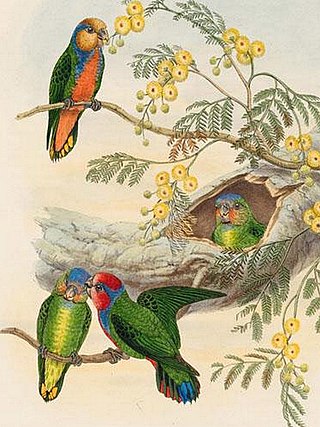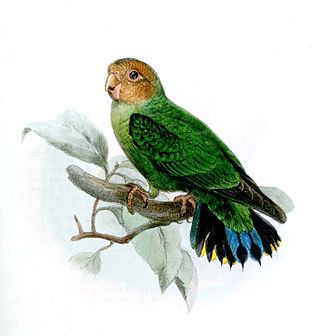
Owlet-nightjars are small crepuscular birds related to the nightjars and frogmouths. Most are native to New Guinea, but some species extend to Australia, the Moluccas, and New Caledonia. A flightless species from New Zealand is extinct. There is a single monotypic family Aegothelidae with the genus Aegotheles.

The Accipitrinae are the subfamily of the Accipitridae often known as the "true" hawks, including all members of Accipiter and the closely related genera Microspizias, Erythrotriorchis, and Megatriorchis. The large and widespread genus Accipiter includes goshawks, sparrowhawks, the sharp-shinned hawk and others. They are primarily woodland birds that hunt by sudden dashes from a concealed perch, with long tails, broad wings and high visual acuity facilitating this lifestyle. In light of recent genetic research, the kites of the traditional subfamily Milvinae may also belong to this group.

Members of the parrot genus Psittacula or Afro-Asian ring-necked parrots, as they are commonly known in aviculture, originate from Africa to South-East Asia. It is a widespread group with a clear concentration of species in south Asia, but also with representatives in Africa and the islands of the Indian Ocean. This is the only genus of parrot which has the majority of its species in continental Asia. Of all the extant species only Psittacula calthropae, Psittacula caniceps and Psittacula echo do not have a representative subspecies in any part of mainland continental Asia. The rose-ringed parakeet, Psittacula krameri, is one of the most widely distributed of all parrots.
Albert Stewart Meek was an English bird collector and naturalist.

The Amboyna cuckoo-dove is a dove in the genus Macropygia found in the Moluccas and New Guinea. It was one of three new species defined when the slender-billed cuckoo-dove was split up in 2016 and retains the Latin binomial of the former species.[1]

The genus Prioniturus, commonly known as racket-tails, contains nine parrot species found in the Philippines and Indonesia. They are easily distinguished from all other parrots by their elongated central tail feathers with the bare shaft and spatula at the end.

The red-breasted pygmy parrot is a species of parrot in the family Psittaculidae. Its natural habitat is the boreal forests, subtropical or tropical dry forests, and subtropical or tropical moist lowland forests of the Maluku Islands and Melanesia.

Finsch's pygmy parrot, also known as the emerald pygmy parrot and green pygmy parrot, is a member of parrot family Psittacidae inhabiting tropical rainforest regions of islands in Papua New Guinea, the Solomon Islands, and the Bismarck Archipelago.

The Geelvink pygmy parrot is a species of parrot in the family Psittacidae endemic to Biak and Numfoor islands in Western New Guinea. The name Geelvink comes from a Dutch ship and family called Geelvinck. It has two subspecies; the nominate occurs on Numfor, and M. g. misoriensis on Biak.

The yellow-capped pygmy parrot is a species of parrot in the family Psittacidae mainly found throughout western New Guinea. Its natural habitats are subtropical or tropical moist lowland forest, subtropical or tropical mangrove forests, and subtropical or tropical moist montane forest. Like many parrots, this pygmy parrot is affectionate to its mate. It is currently unknown if they remain monogamous for life like many bigger parrots because of their isolated location, which is difficult to reach.
Meek's pygmy parrot, also known as the yellow-breasted pigmy parrot, is a species of small parrot in the family Psittacidae. It is endemic to Papua New Guinea.

The buff-faced pygmy parrot is a very small green parrot found in subtropical or tropical moist lowland forest in New Britain and New Guinea.

Neopsittacus is a genus of parrot in the family Psittaculidae. The genus contains two species, both of which are native to New Guinea.

Antonie Augustus Bruijn was a Dutch navy officer, naturalist and trader in naturalia from the Dutch East Indies. He was the son-in-law of Maarten Dirk van Renesse van Duivenbode who from 1858 to 1861 provided lodging and assistance to Alfred Russel Wallace when he traveled through the Moluccan islands.

The parrot subfamily Psittaculinae consists of three tribes: the Polytelini with three genera, the Psittaculini or Asian psittacines, and the pygmy parrots of the Micropsittini tribe.

The variable goshawk is a bird of prey native to Indonesia, Papua New Guinea and the Solomon Islands. It was recently elevated to species status, and was previously lumped together with the grey goshawk.













